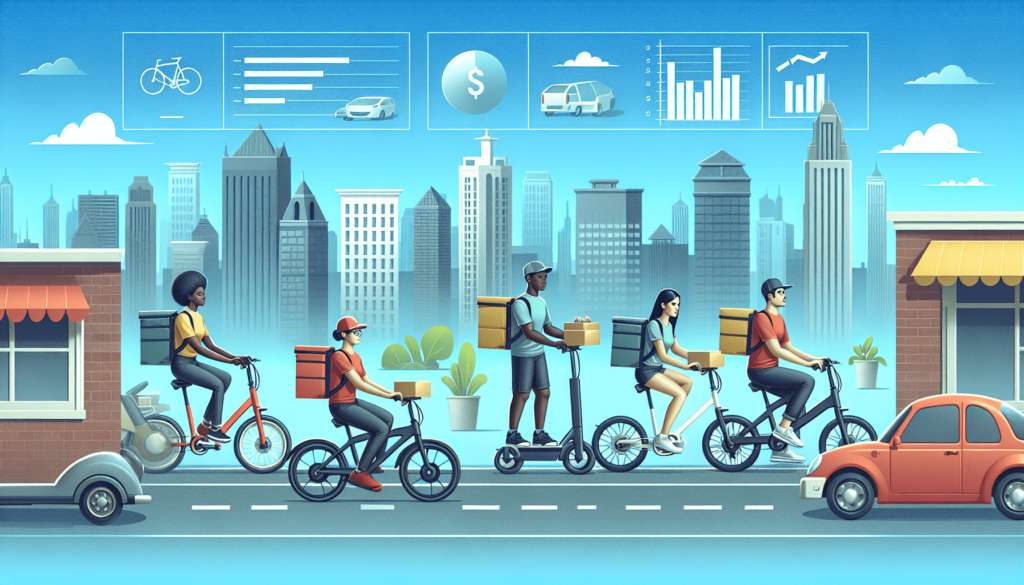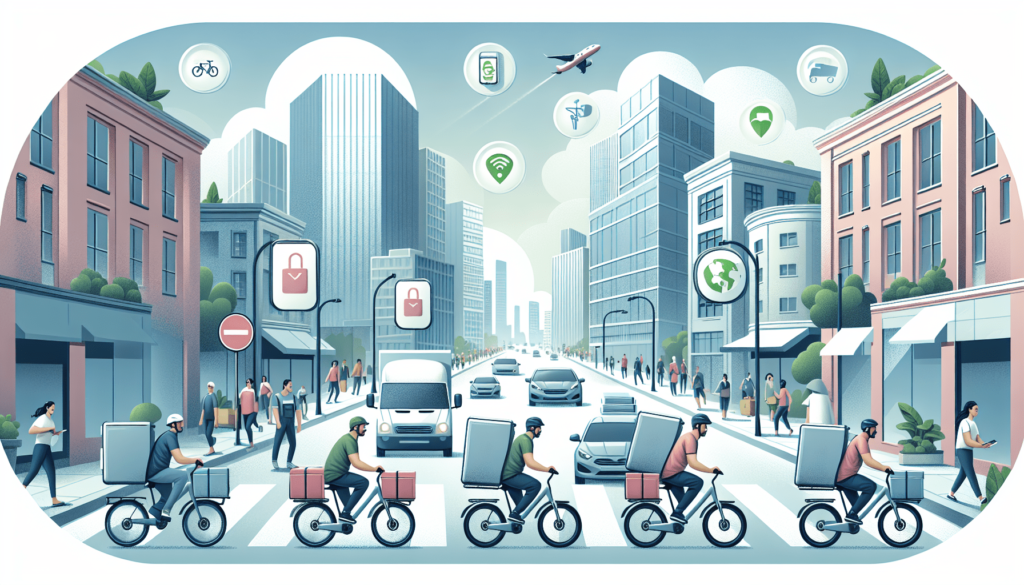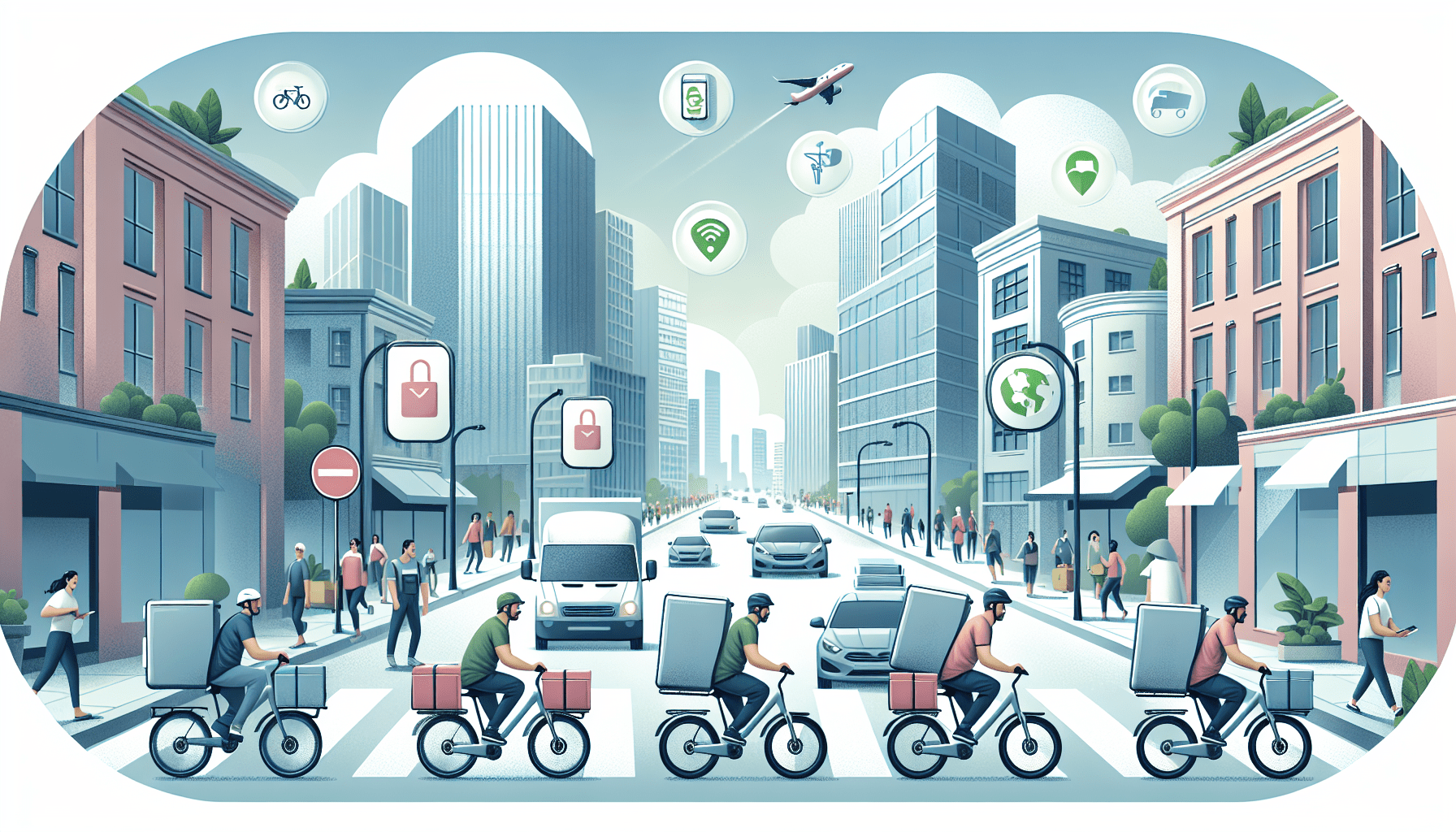If you’re in the food delivery business and looking to shake things up, consider this: e-bikes could be your secret weapon. With the rising popularity of electric bicycles, many food delivery companies are embracing this eco-friendly mode of transportation. In this article, we’ll explore the benefits of using an e-bike for food delivery services and how it can revolutionize your business. From increased efficiency and flexibility to reducing your carbon footprint, get ready to take your food deliveries to new heights with the help of e-bikes.

Legal Regulations
Understanding local laws and regulations
Before using an e-bike for food delivery services, it is crucial to understand and comply with the local laws and regulations in your area. Different jurisdictions may have specific rules regarding the use of electric bicycles for commercial purposes. Familiarize yourself with the requirement for licenses, permits, and any other legal obligations to ensure that you operate within the boundaries of the law.
Checking if e-bikes are permitted for food delivery
In some areas, e-bikes may not be permitted for use in commercial activities such as food delivery. Research local regulations to determine if e-bikes can be used for this purpose. It is essential to know if there are any restrictions on the type of e-bike allowed, such as the maximum speed or power output. Understanding these regulations will help you avoid any legal issues and ensure a smooth and compliant food delivery service.
Obtaining necessary licenses and permits
If e-bikes are permitted for food delivery in your area, you may need to obtain specific licenses or permits. Contact local authorities or relevant agencies to inquire about the requirements for operating an e-bike for commercial purposes. It is important to complete any necessary paperwork and fulfill all legal obligations before starting your food delivery service. Compliance will not only ensure your business operates legally but also help build trust with potential customers.
Suitability of E-bikes
Assessing the capability of e-bikes for food delivery
E-bikes can be a practical and efficient mode of transport for food delivery services. However, it is crucial to assess their suitability based on the specific demands of your business. Consider factors such as the distance of deliveries, terrain, and the weight of the food items you’ll be carrying. Evaluate the battery capacity, motor power, and overall durability of the e-bike to ensure it can withstand the demands of your delivery service.
Considering the range and speed of e-bikes
The range and speed of an e-bike are essential considerations for food delivery services. Analyze the estimated range of the battery per charge and compare it to the distance you need to cover for your deliveries. Additionally, consider the speed at which the e-bike can operate comfortably. Ensure that the e-bike’s specifications align with your delivery requirements to guarantee efficient and timely service.
Evaluating the carrying capacity of e-bikes
The carrying capacity of an e-bike is another crucial factor to consider. Assess the size and storage options of the e-bike, including baskets, racks, or compartments, to determine if it can accommodate your food delivery needs. Consider the volume of orders you typically receive and whether the e-bike can comfortably transport multiple deliveries in a single trip. Understanding the carrying capacity will help you optimize your delivery service for maximum efficiency.
Benefits of Using E-bikes
Cost-effectiveness compared to motor vehicles
One of the significant benefits of using e-bikes for food delivery is their cost-effectiveness. Electric bicycles have lower operational costs compared to motor vehicles. Charging the battery is significantly cheaper than refueling a gas-powered vehicle, and maintenance costs tend to be lower as well. By utilizing e-bikes, you can save money on fuel and reduce overall operating expenses, contributing to increased profitability for your food delivery business.
Reduced environmental impact
Using e-bikes for food delivery services offers a more environmentally friendly alternative to traditional motor vehicles. Electric bicycles produce zero emissions, helping to reduce air pollution and carbon footprint. By choosing e-bikes, you contribute to a cleaner and greener environment. This eco-friendly approach can also resonate with environmentally conscious customers and enhance your brand’s reputation.
Convenience in navigating congested urban areas
In busy urban areas, e-bikes provide a convenient advantage for food delivery services. The compact size and maneuverability of e-bikes allow you to navigate through traffic and congested streets with ease. Unlike larger motor vehicles, e-bikes can weave through tight spaces and find parking more easily. Their ability to bypass traffic jams and deliver food quickly can significantly improve the efficiency and speed of your food delivery service.
Choosing the Right E-bike
Considering the type and model of e-bike
When choosing an e-bike for food delivery, it’s important to consider the type and model that best suits your needs. There are various types of e-bikes, such as city bikes, cargo bikes, and folding bikes, each with its own advantages and limitations. Evaluate the different options based on factors like stability, cargo capacity, and ease of use. Select a model that aligns with your delivery requirements and provides a comfortable and efficient riding experience.
Assessing battery life and charging options
The battery life of an e-bike plays a crucial role in its suitability for food delivery services. Consider the range the battery can provide per charge and how it aligns with your delivery distances. Assess the charging options available for the e-bike, such as removable batteries or the availability of charging stations in your area. Understanding the battery life and charging options will help you plan for efficient delivery schedules and minimize downtime due to battery depletion.
Evaluating e-bike features for food delivery purposes
Different e-bikes come with specific features that can enhance their usability for food delivery. Look for features such as integrated racks, baskets, or panniers that can facilitate the transportation of food items. Other features like lights, fenders, and suspension can improve safety and comfort during food delivery. Evaluating and selecting e-bikes with features specifically designed for food delivery purposes can optimize your operations and improve the overall customer experience.

Safety Considerations
Wearing appropriate safety gear
Safety should be a top priority when using e-bikes for food delivery services. Always wear appropriate safety gear, including a helmet, reflective clothing, and sturdy footwear. Protecting yourself with the right gear can reduce the risk of injuries and ensure your overall well-being while on the road. Remember, you are not only responsible for your own safety but also for the food you are delivering.
Understanding traffic laws and road safety
As a rider, it is essential to have a thorough understanding of traffic laws and road safety regulations. Familiarize yourself with the rules specific to e-bikes in your area, such as speed limits and designated bike lanes. Be attentive to your surroundings, follow traffic signals, and practice defensive riding techniques. Adhering to traffic laws and prioritizing road safety will help prevent accidents and ensure a smooth and efficient delivery service.
Securing food delivery bags and items on the e-bike
To ensure the safety of the food you deliver, it is crucial to properly secure the delivery bags and items on your e-bike. Make use of suitable fasteners, bungee cords, or cargo nets to keep the food items stable during transit. Avoid overloading the e-bike and distribute the weight evenly to maintain balance and stability. By securing the food properly, you can minimize the risk of spills, damage, and accidents while maintaining the quality of the delivered items.
Managing Deliveries
Planning efficient routes
Efficient route planning is essential for managing food deliveries effectively. Utilize mapping or route planning tools to identify the most optimized routes for multiple deliveries. Consider factors like distance, traffic patterns, and delivery time windows. By planning efficient routes, you can reduce delivery times, minimize fuel consumption, and increase the overall productivity of your food delivery service.
Staying organized with delivery orders
To ensure a smooth and organized food delivery service, it is crucial to have a system in place for managing delivery orders. Utilize technology such as delivery management software or mobile applications that allow you to receive, track, and prioritize orders efficiently. Organize your delivery bags or containers to match the order sequence, making it easier to locate and deliver the correct items promptly. Being organized will help you provide timely and accurate deliveries, enhancing customer satisfaction.
Ensuring timely and accurate deliveries
Timely and accurate deliveries are vital in providing exceptional food delivery services. Set realistic delivery time expectations and ensure you can meet or exceed them. Effective communication with customers, including updating them on the status of their delivery, can help manage expectations and maintain a high level of customer satisfaction. Additionally, plan your schedule in a way that allows for contingencies and unexpected delays to ensure timely and accurate deliveries.
Weather Conditions
Considering the impact of weather on e-bike performance
Weather conditions can significantly impact the performance of e-bikes. Rain, snow, or extreme heat can affect battery life, traction, and overall safety. Consider the weather patterns in your area and evaluate the impact they may have on your e-bike’s performance. Take appropriate measures, such as adjusting your delivery schedules or temporarily suspending services during unfavorable weather conditions, to prioritize safety and maintain efficient operations.
Preparing for rainy or snowy conditions
Rainy or snowy conditions require additional precautions when using e-bikes for food delivery services. Invest in suitable rain gear, such as waterproof clothing and shoe covers, to protect yourself from getting drenched. Ensure that your e-bike is equipped with fenders to prevent mud or water splashing onto the food items during transit. In snowy conditions, be cautious of slippery surfaces and adjust your riding speed accordingly. Prioritizing safety and taking necessary precautions will help you handle adverse weather conditions effectively.
Maintaining visibility during unfavorable weather
Maintaining visibility is crucial, particularly when weather conditions are unfavorable. Ensure that your e-bike is equipped with proper lighting, including front and rear lights, to enhance visibility during low light or rainy conditions. Additionally, consider wearing reflective clothing or accessories to make yourself more visible to other road users. By prioritizing visibility, you can mitigate the risks associated with reduced visibility during inclement weather and improve overall safety.
Maintaining and Servicing E-bikes
Regular maintenance routine for longevity
Maintaining an e-bike is essential to ensure its longevity and optimal performance. Establish a regular maintenance routine that includes tasks such as cleaning, lubricating the chain, checking tire pressure, and inspecting the brakes. Regularly inspect the e-bike for any signs of wear or damage and address them promptly to avoid more significant issues. Following a maintenance routine will extend the lifespan of your e-bike and prevent unexpected breakdowns that can disrupt your food delivery service.
Finding reliable repair and servicing options
Inevitably, your e-bike may require repairs or servicing at some point. Find reliable repair and servicing options in your area to ensure quick and efficient resolution of any issues. Look for authorized service centers or technicians with experience in e-bike repairs. Consider their reputation, turnaround time, and availability of spare parts to make an informed decision. Having access to reliable repair and servicing options will help minimize downtime and keep your food delivery service running smoothly.
Replacing worn-out parts and batteries
As your e-bike ages, certain parts may wear out and require replacement. Monitor the condition of components such as brake pads, tires, and chains regularly. If necessary, replace worn-out parts promptly to maintain the safety and performance of your e-bike. Additionally, keep track of the battery’s health and consider replacing it when its capacity significantly decreases. Regularly replacing worn-out parts and batteries will ensure that your e-bike remains in optimal condition for efficient food delivery services.
Insurance Coverage
Understanding insurance requirements for food delivery services
To protect yourself and your e-bike, it is essential to understand the insurance requirements for food delivery services. Contact insurance providers or consult with an insurance agent specializing in commercial vehicle insurance to determine the coverage you need. Different jurisdictions may have specific regulations for insurance coverage in commercial activities. Compliance with these requirements will provide financial protection in the event of accidents or damage and ensure a smooth operation of your food delivery service.
Choosing appropriate insurance coverage for e-bikes
When selecting insurance coverage for your e-bike, consider factors such as liability coverage, personal injury protection, and property damage coverage. Evaluate the risks involved in food delivery services and choose coverage that adequately protects you, your e-bike, and the delivered items. Additionally, consider coverage for theft or vandalism of your e-bike when it is parked or left unattended. Working with an insurance agent can help you identify the most appropriate insurance options for your specific needs.
Reviewing terms and conditions of insurance policies
Before finalizing any insurance policy, carefully review the terms and conditions to ensure you fully understand the coverage and any restrictions or limitations. Pay attention to details such as deductibles, coverage exclusions, claim procedures, and renewal terms. Familiarize yourself with any specific requirements, such as regular inspections or mileage limitations. Being well-informed about the insurance policy will help you make informed decisions, mitigate potential risks, and ensure that you are adequately protected.
Customer Satisfaction and Feedback
Importance of efficient and friendly service
Providing efficient and friendly service is paramount in ensuring customer satisfaction in the food delivery business. Deliveries should be completed promptly, and customers should be treated with respect and courtesy. Efficient service, where food arrives fresh and at the expected temperature, enhances customer experience and builds loyalty. By consistently delivering exceptional service, you can establish a positive reputation and attract repeat customers.
Addressing customer concerns and complaints
Despite efforts to provide excellent service, there may be instances where customers express concerns or complaints. It is crucial to address these issues promptly and professionally. Actively listen to the customer’s concerns, apologize for any inconvenience caused, and work towards a satisfactory resolution. Providing timely and effective solutions demonstrates your commitment to customer satisfaction and helps maintain a positive relationship with your clientele.
Utilizing feedback to improve food delivery experience
Customer feedback is a valuable resource for improving the food delivery experience. Encourage your customers to provide feedback and actively seek their opinions. Review feedback regularly to identify areas for improvement and adjust your operations accordingly. Whether it’s addressing specific complaints, streamlining delivery processes, or introducing new services based on customer suggestions, utilizing feedback can drive continuous improvement and help you stay competitive in the food delivery industry.
In conclusion, utilizing e-bikes for food delivery services offers numerous benefits, from cost-effectiveness and reduced environmental impact to convenience in congested urban areas. However, it is essential to understand and comply with local laws and regulations, assess the suitability of e-bikes, choose the right model, and prioritize safety. Effective management of deliveries, consideration of weather conditions, and proper maintenance and insurance coverage are also key elements in running a successful and efficient food delivery service. Finally, customer satisfaction and feedback play a crucial role in building a strong reputation and continuously improving the delivery experience.

